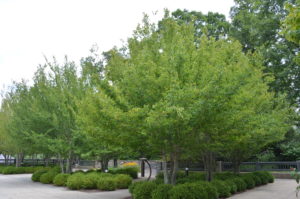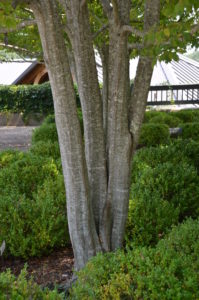American hornbeam (Carpinus caroliniana), aka ironwood or muscle wood, grows primarily in moist, slightly acidic soils along woodland rivers and streams (USDA hardiness zones 3-9). This native hornbeam adapts to either wet or dry ground as long as soil moisture drains off, and it does not flood over long periods. This durable small tree copes with tough urban sites, including non-irrigated parking lots and the outer edges of rain gardens. It grows equally well in full sun or partial shade.
Its autumn foliage turns intense shades of yellow, orange, and at rare times scarlet red, depending on soil pH and the seed provenance of the species. Over the past quarter century Johnson Nursery (wholesale nationwide and retail locally) in Menomonee Falls, Wisconsin has introduced several forms with good fall red foliage. Firespire™ is a grafted clone with semi-upright branching and vibrant red fall color. ‘J N Strain’ is from a known seed population which delivers above average red fall leaf color.
Ironwood blooms in spring as separate male and female catkins, none of ornamental significance. In autumn female catkins produce showy clusters of winged nutlets, that are an important food resource to numerous forest fauna. The main trunk and branches exhibits a muscular beech-like bark, a singular trait that earns it the common names of “musclewood” and “ironwood”. Either single- or multi-trunked, the trunk(s) and boughs are singular assets in the winter garden.
American hornbeam grows 25-40 feet tall and variable in width depending on cultivar. It is free of disease and pest problems when properly sited. Fertilize and mulch the tree in early spring. The rich green summer, colorful autumn foliage, along with its gray muscular winter bark identifies this as an excellent small shade tree. Group several seedling together to develop a deciduous privacy screen.
American hornbeam is more difficult to transplant than European hornbeam (C. betulus), its taller European counterpart.



 Posted in
Posted in 
